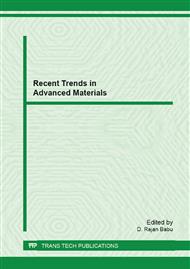[1]
T. Shinmura, K. Takazawa, E. Hatano, T. Aizawa, Study on magnetic abrasive process- finishing characteristics. Bulletin of the Japan Society of Precision Engineering. 18(4) (1984) 347–348.
Google Scholar
[2]
T. Shinmura, K. Takazawa, E. Hatano, Study on magnetic abrasive process-application to plane finishing. Bulletin of the Japan Society of Precision Engineering. 19(4) (1985) 289–291.
Google Scholar
[3]
T. Shinmura, T. Aizawa, Study on magnetic abrasive finishing process-development of plane finishing apparatus using a stationary type electromagnet, Bulletin of the Japan Society of Precision Engineering. 23(3) (1989) 236–239.
Google Scholar
[4]
T. Shinmura, K. Takazawa, E. Hatano, M. Matsunaga Study on Magnetic Abrasive Finishing. Annals of the CIRP. 39(1990) 325–328.
DOI: 10.1016/s0007-8506(07)61064-6
Google Scholar
[5]
V.K. Jain, Prashant Kumar, P.K. Behera, S.C. Jayswal, Effect of working gap and circumferential speed on the performance of magnetic abrasive finishing process, Wear 250 (2001) 384-390.
DOI: 10.1016/s0043-1648(01)00642-1
Google Scholar
[6]
T. Mori, K. Hirota, Y. Kawashima, Clarification of magnetic abrasive finishing mechanism, Journal of Materials Processing Technology. 143-144 (2003) 682-686.
DOI: 10.1016/s0924-0136(03)00410-2
Google Scholar
[7]
Dhirendra K Singh, V.K. Jain, Experimental investigations into forces acting during a magnetic abrasive finishing process, International Journal of Advanced Manufacturing Technology. 30 (2006) 652-662.
DOI: 10.1007/s00170-005-0118-6
Google Scholar
[8]
Dhirendra K Singh, V.K. Jain, V. Raghuram, Parametric study of Magnetic Abrasive finishing process, journal of Materials processing technology. 149 (2004) 22-29.
DOI: 10.1016/j.jmatprotec.2003.10.030
Google Scholar
[9]
Dhirendra K Singh, V.K. Jain, V. Raghuram, R. Komanduri, Analysis of surface texture generated by a flexible magnetic abrasive brush, Wear. 259 (2005) 1254-1261.
DOI: 10.1016/j.wear.2005.02.030
Google Scholar
[10]
Lieh Dai Yang, Ching Tien, Han Ming Chow, Optimization in MAF operations using Taguchi parameter design for AISI304 stainless steel, International journal of Advanced Manufacturing Technology. 42 (2009) 595-605.
DOI: 10.1007/s00170-008-1612-4
Google Scholar
[11]
R.S. Mulik, P.M. Pandey, Experimental investigations and optimization of ultrasonic assisted magnetic abrasive finishing process, Proc.IMechE, Part-B: Journal of engineering manufacture. 225 (2011) 1347-1362.
DOI: 10.1177/09544054jem2122
Google Scholar


